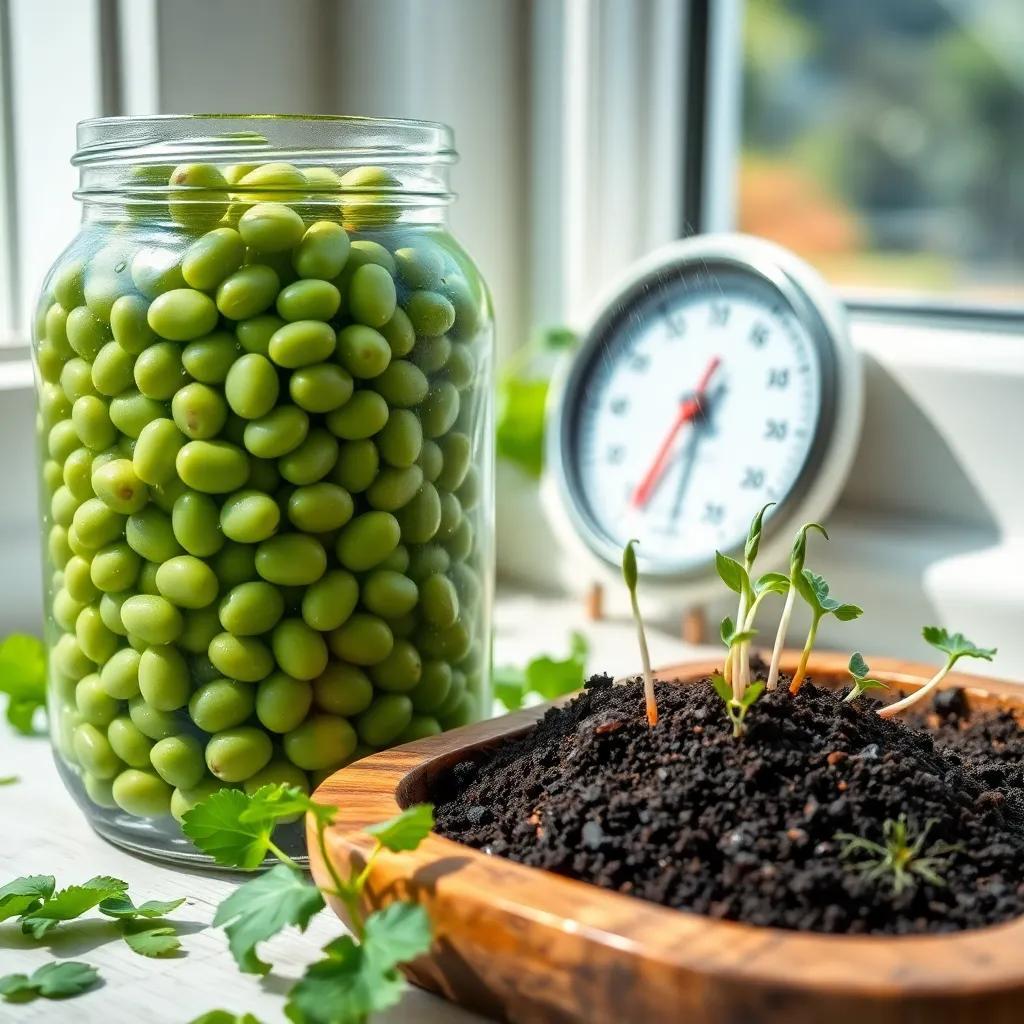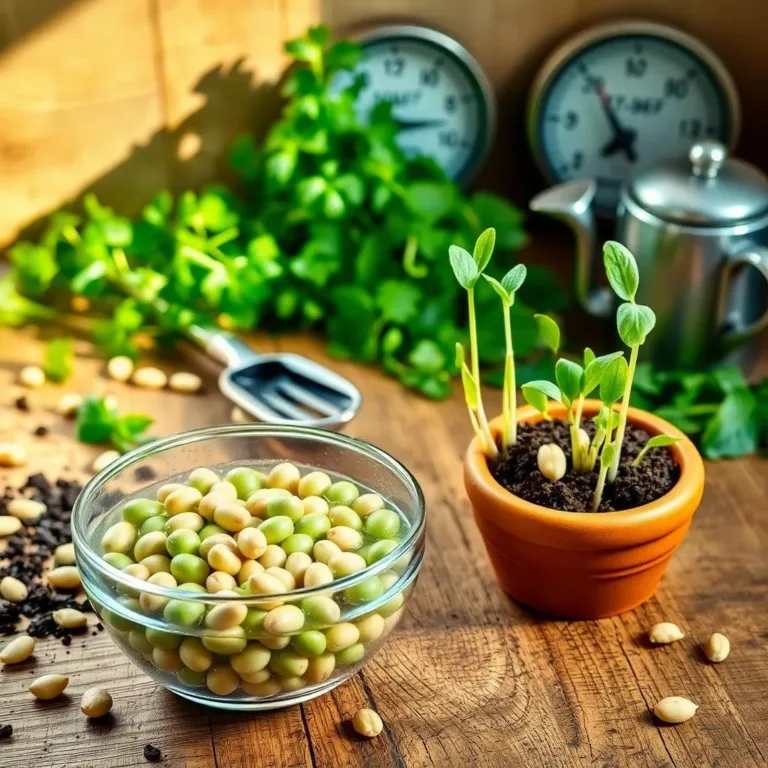Have you ever watched a seed transform into a plant and thought, “Wow, this is magic!”? Growing mung beans is not only fun but also super rewarding! In this article, I’ll share everything you need to know about how to get your mung beans sprouting quickly, the best conditions for them, and a few common mistakes to avoid along the way. Let’s dive into the wonderful world of mung bean gardening together!
Factors Influencing Mung Bean Germination Speed
When it comes to germinating mung beans, there are several factors that can really affect how fast those little seeds take off! It’s like prepping for a race; the better the conditions, the quicker the sprout! Here are the main things I focus on:
- Water: Mung beans thrive on moisture, but not too much! They need enough water to soak and start sprouting, but if the soil is waterlogged, it could drown the seeds. Think of it as giving them a nice drink—just the right amount!
- Temperature: Imagine trying to grow a plant in a refrigerator! Mung beans love warmth. Keeping the temperature around 77-86°F (25-30°C) will do wonders. If it’s too cold, they’ll be like me on a chilly morning—reluctant to get out of bed!
- Light: Surprisingly, these beans don’t require light to get going! In fact, they prefer dark conditions when germinating, so keep them cozy in a shaded spot until they sprout. Who knew they were such introverts?
- Air Circulation: Just like us, mung beans appreciate fresh air! Good ventilation helps avoid fungus and promotes healthy growth. So, if you’re covering them up, make sure there’s some air getting in!
- Seed Quality: Using high-quality seeds is like starting with the best ingredients in a recipe. Look for seeds that are firm and free from damage. This gives you a head start on successful germination!
By paying attention to these factors, you can create the perfect mini-environment for your mung beans. Trust me, once you get the hang of it, you’ll feel like a gardening wizard!
Optimal Conditions for Quick Germination of Mung Beans
Creating the perfect setup for your mung beans is key! If you give them the right conditions, they’ll sprout faster than you can say “green thumb”! Here’s how to do it:
- Moisture: Keep the germination medium evenly moist. Think about it like giving your seeds a spa day! Lightly misting them or covering them with a damp paper towel can help maintain just the right humidity.
- Temperature: Aim for that sweet spot of 77-86°F (25-30°C). You can use a seedling heat mat or place the seeds in a warm area of your home. Just make sure they’re not too close to a heating vent or those seeds might feel like they’re in a sauna!
- Light: Remember, mung beans are not fans of direct sunlight when germinating. Keep them in a dark, warm place until they sprout. Think of it as giving them a little secret hideaway!
- Airflow: Proper ventilation is super important. I like to slightly open lids or cover the seeds with breathable material. It’s like creating a little breeze for them to enjoy!
- Quality Germination Medium: Choose a well-draining soil mix or even a damp paper towel. You want something that holds moisture but won’t turn into a swamp. Nobody likes a soggy bottom!
Keeping these conditions in mind, your mung beans will be ready to sprout in no time! Gardening should be fun, and watching those seeds transform into little plants is absolutely magical!

Germination Timeframe: How Long for Mung Beans to Sprout?
Ah, the wait for those little green marvels to sprout! If you’re like me, you might be peeking under the soil every day, wondering when your mung beans will make their debut! On average, mung beans typically take about 3 to 5 days to germinate under the right conditions. Isn’t that amazing? Here’s a closer look at the germination timeline:
- Days 1-2: It all begins! The mung bean seeds start soaking up water and swelling. This is when they get all cozy and prepare for action. You can almost hear them saying, “Let’s go!”
- Day 3: The first visible sign appears! The radicle (that’s a fancy word for root) breaks through the seed coat and dives into the soil. This little root is crucial as it anchors the seedling and begins absorbing nutrients and moisture.
- Days 4-5: Shortly after, the plumule, or shoot, pokes its way up through the soil. This is where the seedling starts to stretch toward the light, displaying its delicate leaves. You can practically feel the excitement in the air!
Remember, while this timeframe is typical, a few factors can influence how quickly your seeds germinate. Keeping an eye on moisture, temperature, and airflow all play a part in speeding up this process. Before you know it, you’ll have healthy seedlings ready to grow into full-fledged plants!
Tips to Accelerate Mung Bean Germination Process
If you’re itching to see those mung bean sprouts as quickly as possible, I’ve got some tried-and-true tips that have worked wonders for me! With a little prep and a sprinkle of care, you can help your mung beans germinate even faster!
- Pre-soak the Seeds: Soaking your mung beans in water for 4-6 hours before planting can give them the boost they need! This helps soften the seed coat and kickstarts the germination process. Think of it as giving them a mini spa treatment!
- Scarify the Seeds: If you want to get a little crafty, try gently nicking the seed coat with a file or sandpaper. This tiny scratch allows water to penetrate the seed more easily, speeding up germination. Just be gentle—you don’t want to hurt the little guys inside!
- Warmth is Key: Keep your seeds cozy! Maintain a temperature around 77-86°F (25-30°C). A warm spot in your home or a seedling heat mat can help create the perfect environment. It’s like turning up the thermostat for your plants!
- Moisture Control: Make sure your seeds stay consistently moist but not soggy. Misting them lightly or using a damp paper towel can create the ideal humidity for germination. Nobody likes to feel like they’re swimming, right?
- Good Air Circulation: Fresh air is essential! Ensure your seeds aren’t trapped in too much moisture. Slightly opening a lid or using breathable materials can help prevent fungal issues.
By following these simple tips, you’ll be on your way to enjoying a quick and successful mung bean germination process. Happy sprouting!
Common Mistakes in Mung Bean Germination to Avoid
We’ve all made mistakes, and that’s totally okay! But when it comes to growing mung beans, avoiding common pitfalls can save you time and frustration! I’ve gathered a few blunders that I’ve learned from, and I want to share them with you:
- Overwatering: This is the most common mistake! Mung beans dislike soggy conditions. It’s crucial to find the right balance; too much water can overwhelm and rot the seeds. Remember, a light misting is often all they need!
- Planting Too Deep: If you bury those seeds too deep (more than 2 inches), they may struggle to make it to the surface. Mung beans prefer to be planted just below the soil surface in loose, well-draining soil. Think of it as giving them some breathing room!
- Ignoring Temperature: Cold temperatures can slow down germination significantly. Monitor your environment closely! If it’s too chilly, consider moving your seeds to a warmer spot to encourage them to sprout faster.
- Inadequate Light: While mung beans don’t need light during germination, they do benefit from light once they sprout. Make sure they get plenty of indirect sunlight to help them grow strong and healthy!
- Using Old Seeds: Old or poor-quality seeds might not germinate at all. Always opt for fresh, healthy seeds from reputable sources. Think of it as starting with the best ingredients when you cook!
By avoiding these common mistakes, you can set your mung beans up for success! Happy gardening, and may your seeds sprout beautifully!

